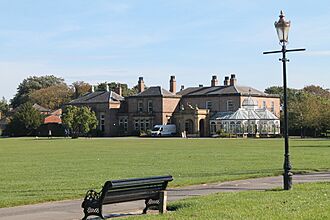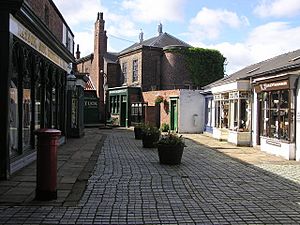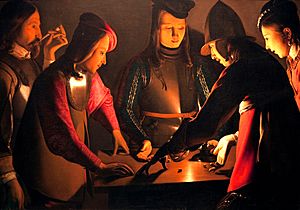Preston Hall, Preston-on-Tees facts for kids
Quick facts for kids Preston Hall |
|
|---|---|

The Hall backed onto a large field
|
|
| General information | |
| Location | County Durham, England, UK |
| Coordinates | 54°32′10″N 1°20′13″W / 54.536°N 1.337°W |
| OS grid | NZ430158 |
Preston Hall is an old, grand house built in the early 1800s. It's located near Stockton-on-Tees in England. Since 1953, it has been a museum, owned by the local council. It's a special building, protected for its history. The house sits in a huge park, about 100 acres big. This park is now known as Preston Park.
Contents
History of Preston Hall
The land where Preston Hall stands has a long history. In 1515, a family named Sayer owned the area. Later, during the English Civil War, a Sayer family member supported the King. Because of this, his land was taken by the government at the time.
Building the Hall
In 1820, a man named David Burton Fowler bought the land. He decided to build the current Preston Hall in 1825. It was a simple, two-story house with a separate area for servants. The older house on the land was used as a farmhouse until 1974.
New Owners and Changes
In 1882, a wealthy shipping businessman named Robert Ropner bought the estate. He was a very important person in the area. He made the house much bigger by adding new sections. Around 1900, he also added a beautiful glass room called a conservatory. This room has been fixed up recently. The Ropner family lived in the house until 1937.
Becoming a Museum
The local council bought Preston Hall in 1947. On June 3, 1953, it officially opened as a museum. This was part of the celebrations for Queen Elizabeth II becoming Queen. In the 1970s, the museum added new things, like the popular replica Victorian Street.
What to See at Preston Park Museum & Grounds
Preston Park Museum & Grounds is a popular place to visit. After a big update, it reopened in 2012. In 2013, it was even nominated for a special award called the Art Fund Museum of the Year.
Fun in the Park
The park around the Hall is a great place for families. You can walk through woodlands or along the river. There's also an adventure play area and a skate park. Other fun things to do include:
- Butterfly World: A warm greenhouse filled with different kinds of butterflies and other small animals.
- RiverShack: Where you can rent rowing boats.
- Teesside Small Gauge Railway: A small train ride run by volunteers.
Inside the Museum
The idea to turn Preston Hall into a museum came after plans to build houses there didn't work out. The museum first opened in 1953. In 2008, it received a large grant of £3.7 million to make big improvements to the building and its collections.
Today, Preston Park Museum & Grounds has four main areas. These areas tell the stories of the Hall, the local area, and the people who lived there. They also show off many amazing items from the museum's collection.
Famous Art and Collections
One of the most famous items is a painting called The Dice Players by Georges de La Tour. This painting is part of a special collection given to the museum. The museum also has a great collection of old weapons, armor, and beautiful decorative items. There's also a collection of ceramics and glassware.
Step Back in Time on Victorian Street
The replica Victorian Street is a favorite for many visitors. It's built in the old service areas of the Hall. It shows what life was like in 1895. You can explore recreated shops and visit a working tearoom. People dressed in old costumes help bring the street to life. This street is even used sometimes for TV shows and movies!
The Walled Kitchen Garden
A special part of the museum's update was fixing up the Victorian Walled Kitchen Garden and Orchard. This type of garden was common at large old houses. Now, it's full of bright flowers and old types of fruits and vegetables. You can visit it during spring and summer.
The museum also has spaces for temporary exhibitions. These shows change throughout the year. They feature items from the museum's own collection, local history, and traveling exhibitions from other places.
The Dice Players Painting
The museum is home to a very important oil painting called The Dice Players. It was painted by a famous French artist named Georges de La Tour. Experts consider it an excellent example of his work. It's not only on display at the museum but has also been shown in major art exhibitions around the world.
The painting became part of the museum's collection in 1934. It was given by Annie Clephan in memory of her father, Edwin Clephan, who was born in Stockton. For a long time, people didn't realize how important this painting was. In 1972, an art expert was looking at the collection. He thought the painting was special and asked another expert, Benedict Nicholson, for his opinion. Mr. Nicholson confirmed that it was indeed painted by Georges de La Tour.



